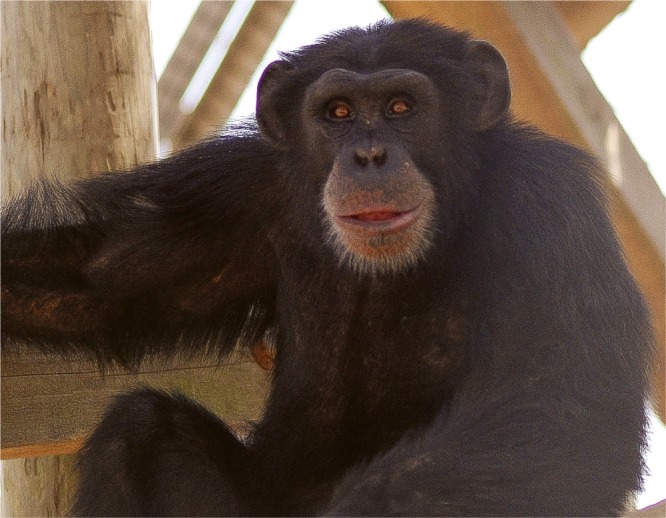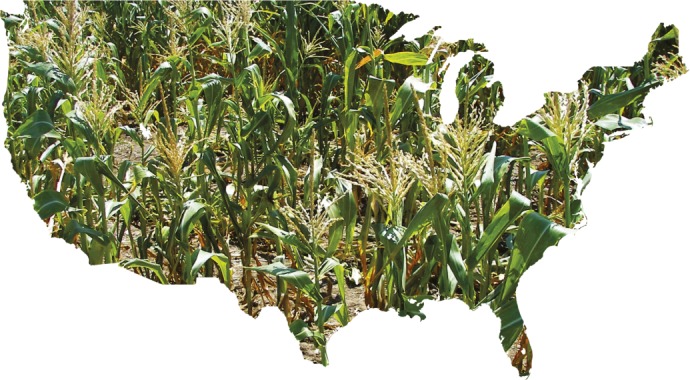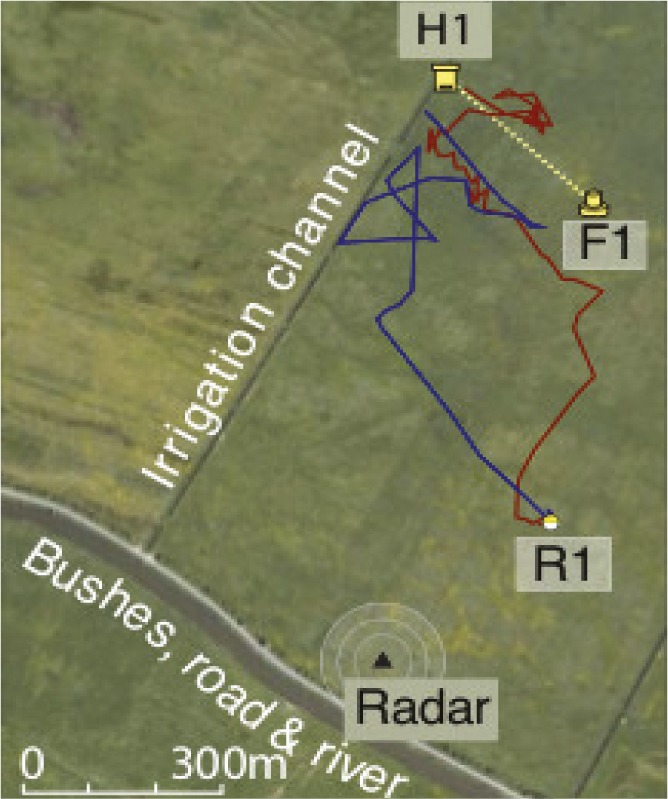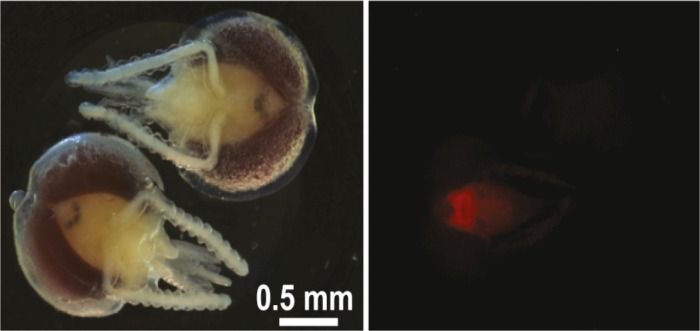Ebola vaccine trial for chimpanzees

Chimpanzee at the New Iberia Research Center, where the first conservation vaccine trial was conducted. Image courtesy of Jeremy Breaux (New Iberia Research Council, New Iberia, LA).
Chimpanzees and gorillas are threatened by recent Ebola virus outbreaks, which have killed nearly one-third of the world’s gorillas, now classified as critically endangered. Human respiratory viruses cause half of all deaths among apes habituated to human approach for research and tourism. To evaluate whether vaccination is safe for wild apes, Kelly Warfield et al. (pp. 8873–8876) conducted a vaccine trial on captive chimpanzees, testing a vaccine that contains a virus-like particle rather than live virus. The authors vaccinated six chimpanzees with two different vaccine formulations containing a fragment of the Ebola virus coat protein. Vaccinated chimpanzees maintained normal weight, blood chemistry, and hematology, and displayed no symptoms of Ebola virus infection. Further, the chimpanzees developed a robust immune response similar to that observed in macaques challenged with Ebola virus infection. The chimpanzees in the study were not challenged with Ebola infection, but when antibodies from the vaccinated chimpanzees were isolated and transferred to mice challenged with Ebola, mouse survival rate rose from zero to 30% or 60%, depending on the vaccine formulation. According to the authors, the results suggest that noninfectious virus-like particles have the potential to provide a safe and effective means of vaccinating wild chimpanzees. — J.P.J.
Geomechanical changes linked to carbon sequestration
Injection of CO2 into deep geological formations may increase fluid pressures in reservoir rocks, possibly inducing fractures and creating a pathway for CO2 to escape. Between 2004 and 2011, the In Salah CO2 storage site received 3.8 million tons of CO2, injected into reservoir rocks beneath a nearly 1 km thick low-permeability caprock seal. Monitoring the site during CO2 injection revealed that fluid pressure, and probably supercritical-phase CO2, had migrated 200 m upward into the lowest caprock layers. Joshua White et al. (pp. 8747–8752) evaluated several hypotheses to explain the pressure migration. The authors report that the shape and orientation of fractures in the lowermost caprock were consistent with fluid pressure-induced fracturing, or hydrofracturing, which is the most likely explanation. Preexisting fractures in the caprock also likely played an important role, the authors report. The results suggest that CO2 injection may have led to geomechanical changes in both reservoir rocks and lower caprock, although there are no indications that the overall storage integrity of the In Salah site has been compromised. No further injection is planned at the site; thus, no further migration is expected, according to the authors. — P.G.
Limitations of climate model downscaling

Maize at Kiefner Farms, Illinois, during the drought of 2012.
Projections of climate change impacts on agricultural yields often employ regional climate models (RCMs) with finer resolution than large-scale global general circulation models (GCMs). Researchers previously used RCMs in the hope that the downscaled, computationally intense regional models would produce better projections than GCMs. To compare the two modeling scales, Michael Glotter et al. (pp. 8776–8781) simulated United States maize yields under current and projected atmospheric carbon dioxide concentrations using climate projections from GCMs and from RCMs driven with the same GCM output. The authors found that although RCMs help correct some GCM biases due to fine-scale geographic features not captured by the coarse resolution of a GCM, errors in RCM agricultural yield prediction stem from wide-scale GCM errors that downscaled RCMs cannot compensate for. The results suggest that the benefits of RCMs for agricultural projection may not outweigh the computational costs, and that efforts to refine projections should focus on minimizing systemic errors in GCM climate projections, according to the authors. — P.G.
Genome editing in bacteria
The ability to edit bacterial genomes is crucial for research and could lead to a range of industrial applications. However, currently available tools do not enable multiplex genome editing—the simultaneous generation of multiple mutations—in nonmodel bacterial species. Ankur Dalia et al. (pp. 8937–8942) developed multiplex genome editing by natural transformation (MuGENT), a method that randomly distributes different combinations of genome edits across cells within a population. This approach relies on natural transformation, a process by which many bacterial species integrate DNA from the environment into the genome. The authors exposed populations of two nonmodel, pathogenic bacterial species, Vibrio cholerae and Streptococcus pneumoniae, to different DNA molecules targeting genes involved in metabolism and natural transformation. This procedure resulted in the incorporation of different sets of mutations, deletions, and insertions into the genomes of about half of the cells in the populations within 1 week, demonstrating that MuGENT is an efficient method for rapidly generating complex mutant pools and screening for cells with desirable properties, such as high rates of natural transformation. According to the authors, MuGENT can provide insights into how pathogens interact with mammalian hosts and help generate mutants with optimal properties for use in the food industry or applications such as biofuel production. — J.W.
Bee navigation and cognitive maps

Similar flight speed and accuracy of bees with (red) and without (blue) clock-shifting.
Mammals navigate by means of cognitive maps, continuous mental maps of familiar terrain built through experience and continually referenced and updated, but it is unclear whether insects navigate in a similar way. James Cheeseman et al. (pp. 8949–8954) tested the hypothesis that displaced bees use terrain landmarks in addition to sun-compass directions to navigate familiar territory. The authors captured and anesthetized honeybees to shift their circadian clocks by 6 hours. Transponders fixed to each bee’s thorax enabled the bees to be radar-tracked upon release in a location different from the point of capture. If bees relied only on the sun to navigate, the authors reasoned, then a circadian shift would disrupt the bees’ ability to locate their hive after release. When the clock-shifted bees were released, they returned to their hive with similar speed and accuracy as bees that had not been clock-shifted. According to the authors, the results suggest that bees may navigate by a mental terrain map in addition to learned sun-compass directions. — J.P.J.
Genetically engineered honeybees

Fluorescent signal from a transgenic marker in the head of a honeybee pupal drone.
Research on honeybee biology is limited by a paucity of genetic tools. Current genetic engineering methods for most insect species yield less than 5% genetically transformed individuals. Rates in honeybees are lower than in many other insects, possibly due to the difficulty of producing queens, the targets of genetic manipulation, in a laboratory setting. Christina Schulte et al. (pp. 9003–9008) used a combination of genetic transformation and rearing methods to produce transformed honeybee offspring. The authors injected fertilized honeybee eggs with transposase mRNA and pBac plasmids, which are specialized for insect cell transformation and contained either a single expression cassette for red fluorescence or two expression cassettes for red and green fluorescence. After the treated eggs hatched, the larvae were transferred to “queen cups” coated with royal jelly, which prompted worker bees to raise the larvae into queens. According to the authors, 27% of the treated queens transferred the red fluorescent reporter gene to their drone offspring, whereas 20% of the treated queens carrying both green and red fluorescent reporter genes transferred both genes to their drone offspring. The rates represent a 6- to 30-fold increase in transformation efficiency over other insect species. According to the authors, the combination of improved transformation and rearing methods may provide an expanded tool set for genetic manipulation of honeybees. — J.P.J.


